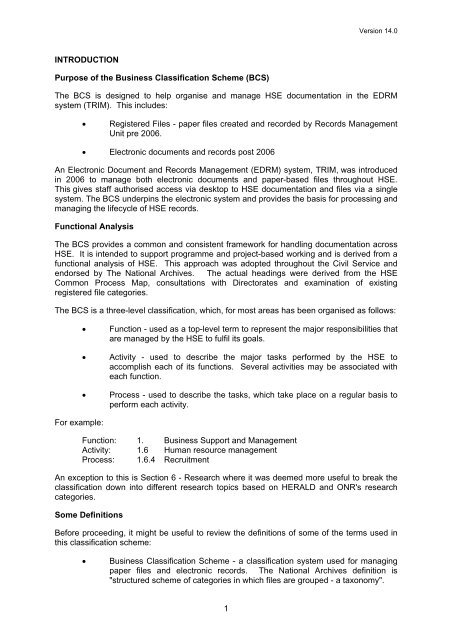Business Classification Scheme and Retention Schedule - HSE
Business Classification Scheme and Retention Schedule - HSE
Business Classification Scheme and Retention Schedule - HSE
Create successful ePaper yourself
Turn your PDF publications into a flip-book with our unique Google optimized e-Paper software.
Version 14.0<br />
INTRODUCTION<br />
Purpose of the <strong>Business</strong> <strong>Classification</strong> <strong>Scheme</strong> (BCS)<br />
The BCS is designed to help organise <strong>and</strong> manage <strong>HSE</strong> documentation in the EDRM<br />
system (TRIM). This includes:<br />
• Registered Files - paper files created <strong>and</strong> recorded by Records Management<br />
Unit pre 2006.<br />
• Electronic documents <strong>and</strong> records post 2006<br />
An Electronic Document <strong>and</strong> Records Management (EDRM) system, TRIM, was introduced<br />
in 2006 to manage both electronic documents <strong>and</strong> paper-based files throughout <strong>HSE</strong>.<br />
This gives staff authorised access via desktop to <strong>HSE</strong> documentation <strong>and</strong> files via a single<br />
system. The BCS underpins the electronic system <strong>and</strong> provides the basis for processing <strong>and</strong><br />
managing the lifecycle of <strong>HSE</strong> records.<br />
Functional Analysis<br />
The BCS provides a common <strong>and</strong> consistent framework for h<strong>and</strong>ling documentation across<br />
<strong>HSE</strong>. It is intended to support programme <strong>and</strong> project-based working <strong>and</strong> is derived from a<br />
functional analysis of <strong>HSE</strong>. This approach was adopted throughout the Civil Service <strong>and</strong><br />
endorsed by The National Archives. The actual headings were derived from the <strong>HSE</strong><br />
Common Process Map, consultations with Directorates <strong>and</strong> examination of existing<br />
registered file categories.<br />
The BCS is a three-level classification, which, for most areas has been organised as follows:<br />
For example:<br />
• Function - used as a top-level term to represent the major responsibilities that<br />
are managed by the <strong>HSE</strong> to fulfil its goals.<br />
• Activity - used to describe the major tasks performed by the <strong>HSE</strong> to<br />
accomplish each of its functions. Several activities may be associated with<br />
each function.<br />
• Process - used to describe the tasks, which take place on a regular basis to<br />
perform each activity.<br />
Function: 1. <strong>Business</strong> Support <strong>and</strong> Management<br />
Activity: 1.6 Human resource management<br />
Process: 1.6.4 Recruitment<br />
An exception to this is Section 6 - Research where it was deemed more useful to break the<br />
classification down into different research topics based on HERALD <strong>and</strong> ONR's research<br />
categories.<br />
Some Definitions<br />
Before proceeding, it might be useful to review the definitions of some of the terms used in<br />
this classification scheme:<br />
• <strong>Business</strong> <strong>Classification</strong> <strong>Scheme</strong> - a classification system used for managing<br />
paper files <strong>and</strong> electronic records. The National Archives definition is<br />
"structured scheme of categories in which files are grouped - a taxonomy".<br />
1
















